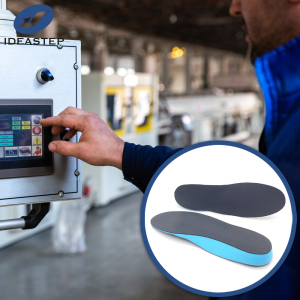
Custom insoles play a crucial role in providing personalized support and comfort for individuals with diverse foot conditions. In the previous blog”What Are The Ways To Customize The Insole?“, we introduced several different ways of customizing insoles. Among them, two common methods for creating custom insoles are EVA (Ethylene Vinyl Acetate) milling and vacuum molding. In this article, we will compare these two approaches and explore their respective benefits and considerations.
EVA Milling:
EVA milling involves the use of computer-aided design (CAD) and computer-aided manufacturing (CAM) technologies to carve out custom insoles from blocks of EVA foam. The process typically includes the following steps:
- Foot Scanning: The individual’s foot is scanned to capture its unique shape and contours.
- CAD Design: Using specialized software, a digital model of the custom insole is created based on the foot scan, allowing for precise customization.
- CAM Milling: The digital design is translated into instructions for a milling machine, which carves the custom insole out of a block of EVA foam with high accuracy.
Benefits of EVA Milling:
- Precision: EVA milling allows for highly precise customization, tailored to the specific shape and needs of the individual’s foot.
- Durability: Insoles produced through EVA milling are often durable and resilient, providing long-lasting support.
- Versatility: This method can accommodate a wide range of foot conditions and provide targeted support where needed.
Considerations for EVA Milling:
- Cost: EVA milling can be more expensive due to the use of specialized equipment and technology.
- Time: The process of EVA milling may take longer compared to other methods, as it involves multiple steps and precise manufacturing.
Vacuum Molding:
Vacuum molding, also known as vacuum forming, involves the use of heat and pressure to create custom insoles that conform to the individual’s foot shape. The process typically includes the following steps:
- Heating: A thermoformable material, such as a thermoplastic, is heated until it becomes pliable and moldable.
- Vacuum Forming: The heated material is placed over a mold of the individual’s foot and then vacuum-sealed to create a custom shape.
- Trimming: Once the material has cooled and taken the desired shape, any excess material is trimmed to ensure a proper fit inside the footwear.
Benefits of Vacuum Molding:
- Efficiency: Vacuum molding can be a relatively quick and efficient method for producing custom insoles, making it suitable for immediate or time-sensitive needs.
- Affordability: This method may be more cost-effective compared to EVA milling, as it requires less specialized equipment.
Considerations for Vacuum Molding:
- Customization Limitations: While vacuum molding provides personalized shaping, it may have limitations in terms of intricate, detailed customization compared to EVA milling.
- Material Selection: The choice of thermoformable material can impact the durability and support provided by the custom insoles.
In conclusion, both EVA milling and vacuum molding offer distinct advantages and considerations in the creation of custom insoles. The choice between these methods should be based on factors such as the level of customization needed, time constraints, material preferences, and individual budget considerations. If you are interested in custom insoles, you can continue to visit this page (https://www.aideastep.com/custom-orthotic/) and tell us your needs.
